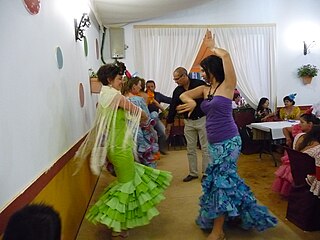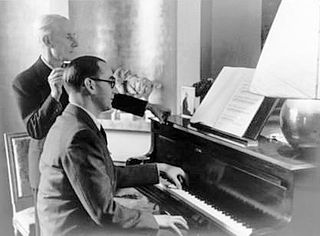Bolero is a genre of song which originated in eastern Cuba in the late 19th century as part of the trova tradition. Unrelated to the older Spanish dance of the same name, bolero is characterized by sophisticated lyrics dealing with love. It has been called the "quintessential Latin American romantic song of the twentieth century".

Boléro is a 1928 work for large orchestra by French composer Maurice Ravel. It is one of Ravel's most famous compositions. It was also one of his last completed works before illness diminished his ability to write music.
The siciliana or siciliano is a musical style or genre often included as a movement within larger pieces of music starting in the Baroque period. It is in a slow 6
8 or 12
8 time with lilting rhythms, making it somewhat resemble a slow jig or tarantella, and is usually in a minor key. It was used for arias in Baroque operas, and often appears as a movement in instrumental works. Loosely associated with Sicily, the siciliana evokes a pastoral mood, and is often characterized by dotted rhythms that can distinguish it within the broader musical genre of the pastorale.

Sevillanas are a type of folk music and dance of Sevilla and its region. They were derived from the Seguidilla, an old Castilian folk music and dance genre. In the nineteenth century they were influenced by Flamenco. They have a relatively limited musical pattern but are rich in lyrics based on country life, virgins, country towns, neighborhoods, pilgrimage, and love themes.

Robert Marcel Casadesus was a renowned 20th-century French pianist and composer. He was the most prominent member of a distinguished musical family, being the nephew of Henri Casadesus and Marius Casadesus, husband of Gaby Casadesus, and father of Jean Casadesus.

The Piano Concerto for the Left Hand in D major was composed by Maurice Ravel between 1929 and 1930, concurrently with his Piano Concerto in G major. The piece was commissioned by Paul Wittgenstein, a concert pianist who had lost his right arm in the First World War.

Rapsodie espagnole is an orchestral rhapsody written by Maurice Ravel. Composed between 1907 and 1908, the Rapsodie is one of Ravel's first major works for orchestra. It was first performed in Paris in 1908 and quickly entered the international repertoire. The piece draws on the composer's Spanish heritage and is one of several of his works set in or reflecting Spain.

The seguidilla is an old Castilian folksong and dance form in quick triple time for two people with many regional variations. The music is generally in a major key and often begins on an offbeat.

Iberia is a suite for piano composed between 1905 and 1909 by the Spanish composer Isaac Albéniz. It is composed of four books of three pieces each; a complete performance lasts about 90 minutes.

The jota is a genre of music and the associated dance known throughout Spain, most likely originating in Aragon. It varies by region, having a characteristic form in Aragon, Catalonia, León, Castile, Navarre, Cantabria, Asturias, Galicia, La Rioja, Murcia and Eastern Andalusia. Being a visual representation, the jota is danced and sung accompanied by castanets, and the interpreters tend to wear regional costumes. In Valencia, the jota was once danced during interment ceremonies.

Castanets, also known as clackers or palillos, are a percussion instrument (idiophone), used in Spanish, Calé, Moorish, Ottoman, Italian, Mexican, Sephardic, and Swiss music. In ancient Greece and ancient Rome there was a similar instrument called the crotalum. The instrument consists of a pair of concave shells joined on one edge by a string. They are held in the hand and used to produce clicks for rhythmic accents or a ripping or rattling sound consisting of a rapid series of clicks. They are traditionally made of hardwood, although fibreglass has become increasingly popular.
The cante flamenco, meaning "flamenco singing", is one of the three main components of flamenco, along with toque and baile (dance). Because the dancer is front and center in a flamenco performance, foreigners often assume the dance is the most important aspect of the art form — in fact, it is the cante which is the heart and soul of the genre. A cante singer is a cantaor or cantaora.
Sebastián Cerezo was a Spanish dancer from La Mancha. In 1799, he was credited by Zamácola y Ocerín as one of the earliest and best dancers of the bolero, a Spanish dance developed between 1750 and 1772, which became very popular in Madrid, La Mancha, Andalusia and Murcia in the 1780s. According to Zamácola y Ocerín, Cerezo danced slowly and his particular way of dancing marked the definitive transition from seguidilla to bolero. This original slow way of dancing was promoted by Murcian dancer Requejo around 1800 in response to the faster style of bolero dancing that had become popular over the years.
Isaac Albéniz’s Suite española, Op. 47, is a suite for solo piano. It is mainly composed of works written in 1886 which were grouped together in 1887, in honour of the Queen of Spain. Like many of Albeniz’s works for the piano, these pieces depict different regions and musical styles in Spain.
Henri Collet was a French composer and music critic who lived in Paris.

Paco de Lucía interpreta a Manuel de Falla is the twelfth studio album by the Spanish composer and guitarist Paco de Lucía. All the pieces were written by Manuel de Falla.

Chants d'Espagne, Op. 232, is a suite of originally three, later five pieces for the piano by Isaac Albéniz. Prélude, Orientale and Sous le palmier were published in 1892, and Córdoba and Seguidillas were added in the 1898 edition. According to Günter Schulze, "Many...[of the works] have the flavor of the flamenco so beloved of Albéniz."[1]
Seguidillas boleras, or simply boleras, is a palo (style) of flamenco music based on the seguidilla poetic form and the Spanish dance known as bolero. It is considered a member of the cante chico family of palos. The term "boleras" was popularized around 1812–13 to designate female dancers who performed boleros. Their particular style gave rise to the bolera school of dance, which was prevalent in Spain throughout the 19th century. To distinguish the sung boleros from the dance itself, the term "seguidilla bolera" is used. Towards the end of the 19th century, the bolero form was incorporated into the flamenco repertoire as a new palo.
Richard Aaker Trythall was an American and Italian composer and pianist of contemporary classical music.
The parranda is a traditional Spanish dance that originated from the Region of Murcia, the eastern areas of Almería, and the southeastern areas of Albacete in the 18th century. It is a dance similar to the seguidilla, and is usually characterized by its usage of extraordinary jumps and turns in the air.














